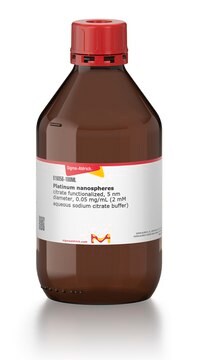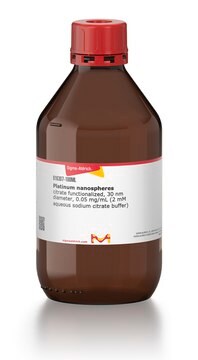773875
Platinum, nanoparticle dispersion
3 nm particle size, 1,000 ppm in H2O, 99.99% trace metals basis
Sinonimo/i:
Platinum colloid, Pt NP, Pt dispersion
About This Item
Prodotti consigliati
Livello qualitativo
Saggio
99.99% trace metals basis
Stato
dispersion
nanoparticle
Impiego in reazioni chimiche
reagent type: catalyst
core: platinum
Concentrazione
1,000 ppm in H2O
Dimensione particelle
3 nm
Densità
0.997 g/mL at 25 °C
Stringa SMILE
[Pt]
InChI
1S/Pt
BASFCYQUMIYNBI-UHFFFAOYSA-N
Applicazioni
Classe di pericolosità dell'acqua (WGK)
nwg
Scegli una delle versioni più recenti:
Possiedi già questo prodotto?
I documenti relativi ai prodotti acquistati recentemente sono disponibili nell’Archivio dei documenti.
I clienti hanno visto anche
Articoli
Electronically, it behaves as a wide band gap (3.2 eV) semiconductor and exhibits memristor properties.2 Optically, TiO2 has high opacity with a very high refractive index3 (>2.4), and it exhibits strong absorbance in the UV range.
The production of hydrogen by catalytic water splitting is important for a wide range of industries including renewable energy petroleum refining and for the production of methanol and ammonia in the chemical industry.
The past several decades have seen major advancements in the synthesis of metal nanomaterials. Most recently, controlled synthesis has become versatile enough to regulate the exact number of atoms and ligands of very small metal nanoparticles, referred to as “clusters”.
Global Trade Item Number
| SKU | GTIN |
|---|---|
| 773875-25ML | 4061832931012 |
Il team dei nostri ricercatori vanta grande esperienza in tutte le aree della ricerca quali Life Science, scienza dei materiali, sintesi chimica, cromatografia, discipline analitiche, ecc..
Contatta l'Assistenza Tecnica.





